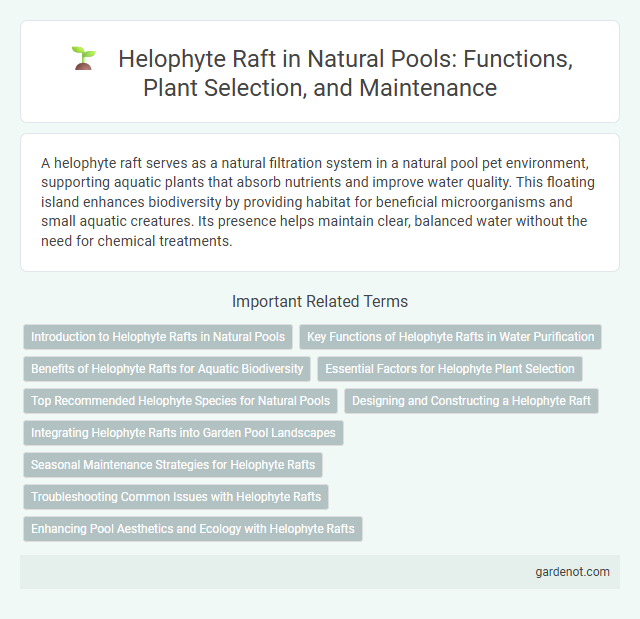A helophyte raft serves as a natural filtration system in a natural pool pet environment, supporting aquatic plants that absorb nutrients and improve water quality. This floating island enhances biodiversity by providing habitat for beneficial microorganisms and small aquatic creatures. Its presence helps maintain clear, balanced water without the need for chemical treatments.
Introduction to Helophyte Rafts in Natural Pools
Helophyte rafts in natural pools serve as biofilters by harnessing the natural filtration capabilities of aquatic plants rooted in a floating substrate. These rafts promote water clarity and ecosystem balance by facilitating nutrient absorption and providing habitat for beneficial microorganisms. Their integration supports sustainable water purification while enhancing biodiversity within the natural swimming environment.
Key Functions of Helophyte Rafts in Water Purification
Helophyte rafts play a crucial role in natural pool water purification by providing a habitat for beneficial microorganisms that break down organic pollutants and absorb nutrients such as nitrogen and phosphorus. These floating plant systems enhance oxygenation and facilitate the biofiltration process, significantly reducing harmful algae growth and improving overall water clarity. Their dense root mats trap suspended solids and promote the uptake of heavy metals and toxins, ensuring a balanced and sustainable aquatic ecosystem.
Benefits of Helophyte Rafts for Aquatic Biodiversity
Helophyte rafts enhance aquatic biodiversity by providing essential habitats and breeding grounds for diverse aquatic species, including fish, amphibians, and invertebrates. These floating vegetative mats improve water quality through natural filtration, promoting a balanced ecosystem that supports a wide range of microorganisms and plants. By fostering increased structural complexity, helophyte rafts create niches that boost species richness and ecological resilience in natural pools.
Essential Factors for Helophyte Plant Selection
Selecting helophyte plants for a natural pool's helophyte raft requires consideration of water depth tolerance, growth rate, and root structure adaptability to ensure effective nutrient uptake and water purification. Native species with high pollutant absorption capacity and resilience to seasonal water level fluctuations promote ecological balance and stable biofiltration. Optimal plant selection also involves assessing compatibility with local climate and ensuring non-invasive propagation to maintain the pool's natural ecosystem integrity.
Top Recommended Helophyte Species for Natural Pools
Top recommended helophyte species for natural pools include common reed (Phragmites australis), soft rush (Juncus effusus), and bulrush (Schoenoplectus lacustris), known for their effective water filtration and habitat support. These helophytes enhance water quality by absorbing excess nutrients and provide structural stability to helophyte rafts. Their adaptability to fluctuating water levels makes them ideal for integrated ecosystem balance in natural pool systems.
Designing and Constructing a Helophyte Raft
Designing and constructing a helophyte raft for a natural pool involves selecting buoyant materials such as polystyrene or recycled plastic to provide stable support for wetland plants. The raft must be dimensioned to maximize surface area while allowing sufficient depth for plant roots to thrive and filter water effectively. Proper anchoring systems are critical to prevent drift and ensure the helophyte raft remains positioned to optimize natural filtration and habitat creation.
Integrating Helophyte Rafts into Garden Pool Landscapes
Helophyte rafts serve as floating biofilters in natural pool ecosystems, enhancing water quality through phytoremediation and oxygenation processes. Integrating helophyte rafts into garden pool landscapes creates a visually appealing habitat that supports biodiversity by providing shelter and food for aquatic fauna. These rafts stabilize water chemistry and reduce nutrient loads, promoting sustainable, chemical-free pool management.
Seasonal Maintenance Strategies for Helophyte Rafts
Seasonal maintenance strategies for helophyte rafts in natural pools include removing dead plant material in late winter to prevent decay and nutrient buildup, which can lead to algae growth. Regular inspection during spring ensures healthy root development and effective water filtration as plants resume growth. In autumn, trimming overgrown vegetation and replenishing substrate promotes optimal nutrient uptake and maintains the structural integrity of the raft.
Troubleshooting Common Issues with Helophyte Rafts
Helophyte rafts in natural pools can face common issues such as plant decay, algae overgrowth, and inadequate water flow, which disrupt filtration efficiency. Regular monitoring of nutrient levels and ensuring proper sunlight exposure helps prevent algae blooms, while removing dead plant material maintains raft health. Adjusting the raft's position to optimize water circulation enhances oxygen supply, supporting healthy microbial activity crucial for effective water purification.
Enhancing Pool Aesthetics and Ecology with Helophyte Rafts
Helophyte rafts serve as natural biofilters, improving water clarity and quality by supporting beneficial microbial communities and nutrient absorption in natural pools. These floating platforms enhance pool aesthetics by integrating lush aquatic plants, creating a visually appealing and dynamic ecosystem. The incorporation of helophyte rafts promotes biodiversity, providing habitat for amphibians and insects while maintaining balanced ecological conditions.
Helophyte raft Infographic

 gardenot.com
gardenot.com